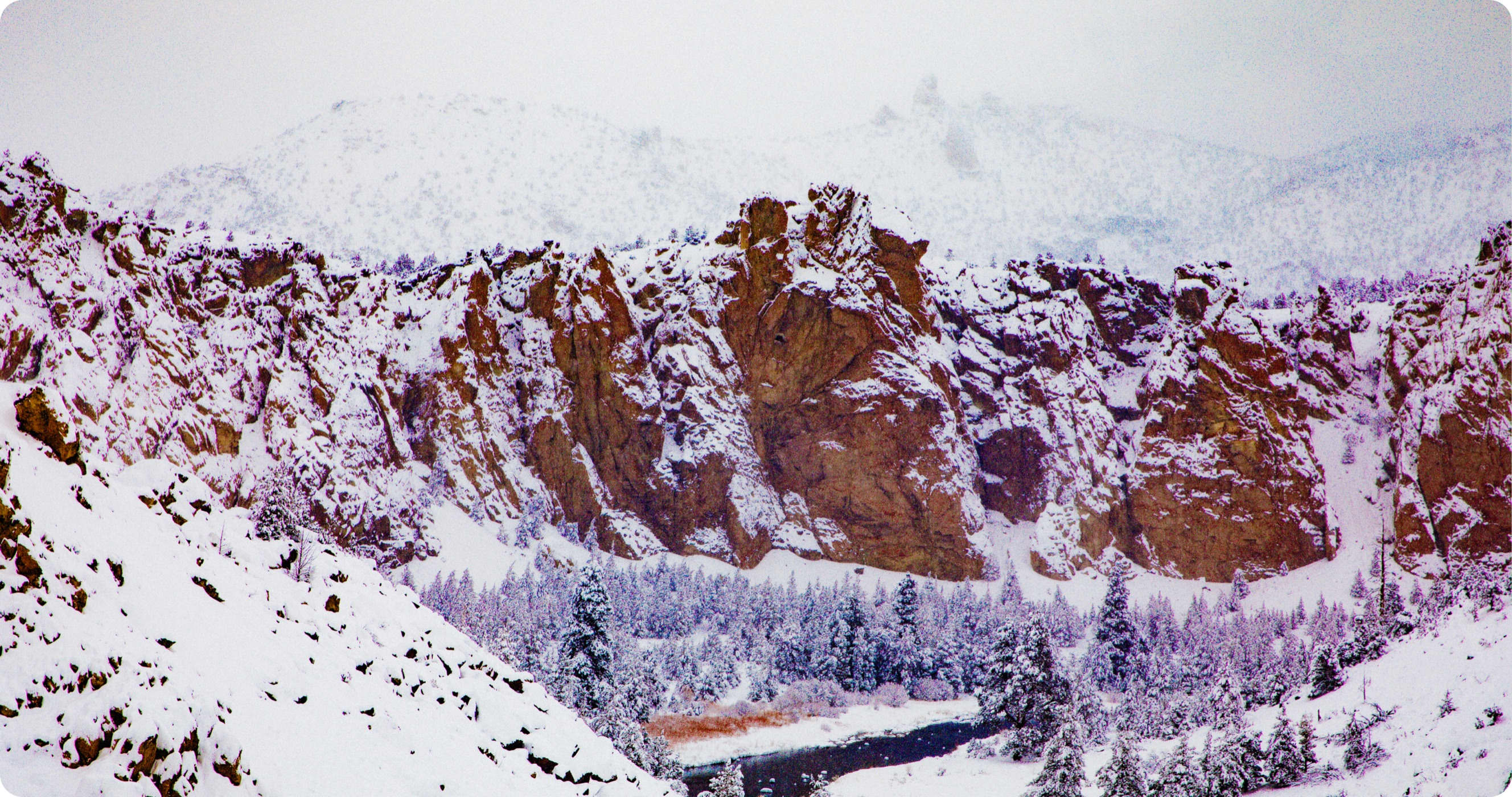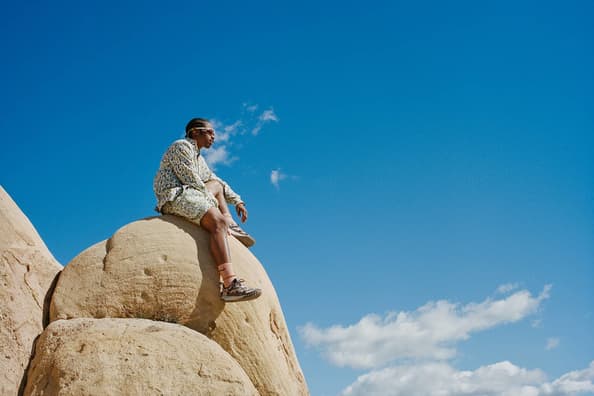
Behind the Design: Smith Rock
Things might have gone differently had we known the snow was going to get so bad that the Governor would declare a State of Emergency, due to more than 60 centimetres of wet, February snow accumulating in the high desert of Oregon. That's the thing about the wilderness, though—it's wild.

It had been snowing steadily when we set out on our design-inspiration trip to Smith Rock. We were determined to get out from underneath the lights of the office, breathe some fresh air and soak in the outdoors to draw inspiration for the next ACG season. The summer before, wildfires had knocked out the shallow pass that runs from Marion Forks through Black Butte and Sisters to Smith Rock. The only way to get there that February was over Mount Hood, the highest point in Oregon.
Undaunted, nine of us gathered in a chilly Nike car park that morning. Footwear and apparel designers, marketing folks, brand designers and sales reps piled into three cars and set out from Nike HQ in Beaverton, passing towns like Zigzag and Rhododendron at the foot of Mount Hood. Outside of Government Camp, the snow started coming down in earnest.

After seeing a few eighteen-wheelers overturned in the ditches to the side of the road, we decided the best course of action would be to follow the signs on the side of the road reading, "USE SNOW CHAINS". On our knees at the side of the road, cars flying by on the icy tarmac, we helped each other decipher the instructions for our snow chains: check the diamond shape, pull forwards 4.5 metres, tighten again. Certain that our chains would hold and give us the extra traction we needed to get through the mountain pass in a blizzard, we carried onwards.


It was slow going. The afternoon wore on as we crossed the Deschutes River. The recommended maximum speed for snow chains is 25 miles per hour and the limited visibility had us travelling slower than that. When our convoy finally reached Smith Rock, the sun was sinking low behind the western clouds.
Smith Rock is usually bathed in sunlight; the high desert in Oregon gets over 300 days of sunshine a year, so seeing the monolith covered in several inches of snow was astonishing. We had originally planned to do a pleasant hike called "Misery Ridge" around the northwest side of Smith Rock, with a quick 220-metre elevation gain to a lookout where, on a good day, you can see climbers and slack liners on the famous Monkey Face climbing route. However, due to the intense weather all of the trails were closed.

Some people might be discouraged after travelling seven hours through treacherous mountain passes and foul weather only to find their objective closed. We are not those people. After hours in the car, just being outside was its own reward. The atmosphere was otherworldly at the foot of Smith Rock, while the snow in the air muffled all sounds and a horse trudged, knee deep, through the driving snow across the road. The light seemed to glow up off the frosty ground. We ran out into the snow, made snow angels and chased each other with snowballs until it was almost too dark to see. After all, our goal was to immerse ourselves in the atmosphere of Smith Rock itself and learn from what we saw and felt, come what may.

With the light fading rapidly, we headed to our home for the evening, a rustic lodge on the shore of Suttle Lake, nestled between Mt Jefferson and Three Fingered Jack—a dormant volcano named after a surly prospector from the early days of the Oregon Territory. The lodge loomed in our headlights, warm and inviting. As we pulled into the almost-empty car park, the snow continued to gather around our tyres and we hauled our bags into the entrance.

Out in the wilds of Oregon, mobile reception is spotty, and because of the extreme snowfall, the Wi-Fi at the lodge had been knocked out. Although it was hard not to be able to contact our families to let them know that we had made it through the storm, there was something special about being cut off from the outside world. It's so easy to get distracted from what's right in front of you with the infinite scroll of the internet and social media. Sometimes, it's important to unplug and refocus on the natural world.

Snowed in for the evening, we followed a time-honoured snow-day tradition: start a fire and relax. Over some steaming drinks, we gathered around the bar and shared ideas and observations from the day. Comparing notes on how our gear had functioned both on the road as well as out in the elements, we gained new perspectives on performance and discussed ways to improve on the next season of ACG. After talking about design, we retired to the lodge's lounge area where we found a bookshelf filled with everything from pulp novels to old wilderness guides. Cut off from the outside world, we took turns reading to each other, randomly selecting titles from the shelf. For some people, this was their first trip with ACG, while others had been around for years. Having the chance to switch off, be present and have a little fun with the accumulated design team was, in some ways, as important as sharing product and feature feedback. It created connection and cohesion between our entire group.

We wanted to show you the future of ACG footwear. Nike's legal team wouldn't let us :(
After breakfast the next morning, we all met in the lounge again to have another inspiration session. This time, everyone brought down their packs and we took turns presenting a flat-lay of the gear we had brought on the trip, discussing what gear we couldn't have lived without, what gear we brought that we didn't end up using, and showing outdoor gear that we think is unique. As we went around the room, we heard from seasoned outdoorsmen and city connoisseurs, each person sharing their own perspective on what was important when it came to getting outside. Through this little game of show-and-tell, we started to recognise patterns, develop new ideas and align on the direction for the next season of ACG.

Pulling out of the car park, there was a palpable sense of connection between our crew. We all felt energised as we carefully made our way over the snow-covered roads back to Portland, ready to bring what we had learnt from each other and from our time out in the world back to the drawing board. And that's why design should be done in the wild. You see things you wouldn't see in a studio; you get to tap into the environment and draw from its energy, understand its challenges and reflect on what it feels like to truly experience a place with all of your senses. You can test theories, share ideas and build on the collective energy of people and place together.
When we partner with a place to create something new, we speak for that place. The places we have chosen as our inspiration are wild places, the rough magic of the outdoors. And when we speak for the outdoors, we speak for the Earth, and the Earth speaks for us all.

